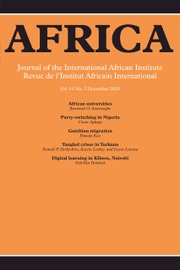In the past ten years, histories of the ethics of biomedical research and the practices of biomedicine have taken centre stage in the historiography of health and healing on the African continent. These works push beyond some of the more established ways of addressing biomedicine in an African context, such as exploring colonial medicine as a form of colonial domination and African resistance or the entanglements of traditional and Western therapeutics as patients and caretakers navigate a therapeutic landscape shaped by pluralism. In addition, these new works historicize and theorize the rise of globalized pharmaceutical trials and medical research.
Traces of the Future is the latest collective instalment by a group of historians, anthropologists, science and technology studies scholars and biomedical scientists who have been in conversation with one another for over a decade. Other volumes have come before this one, notably Evidence, Ethos and Experiment, Para-States and Medical Science and Making and Unmaking Public Health in Africa. This volume is the most experimental and visually driven, combining archival photographs, excerpts from field notes, experimental essays, and snapshots of interviews. It is a truly collective endeavour, combining the voices of eighteen artists and scholars. This book is a constellation of traces from a collaborative group that will eventually dissolve, transform or take on a new shape and form, much like the scientific labs and groups of actors depicted in the book itself.
The core argument of the book is that medical and scientific research in Africa disrupts time in fascinating ways. The contributors and editors argue that a close attention to the material, personal and affective traces of the past that are present in the contemporary moment can tell us much about how Africans imagined their scientific and medical futures in the 1940s, 1950s and 1960s. The authors are particularly interested in excavating the unintentionality of what is left behind and how to interrogate future-making from the remnants of the past. They write that the ‘affective making of the present upon the materials of the past is what this book is about … We look at archives ethnographically, treating them as subjects and forms, not merely as sources.’ Picking up where Nancy Rose Hunt's A Colonial Lexicon ended, they use ‘debris as method’ to open up a conversation about the past and present, logging a ‘diary of encounters’ that then provides the basis of the evidence and analysis in the book.
The book is arranged around telling the story of five iconic sites of medical research in Africa – Uzuakoli in Nigeria, Ayos in Cameroon, Amani in Tanzania, Niakhar in Senegal, and Kisumu in Kenya. Each site offers a unique theoretical intervention and excavates a particular history of medical research that is sometimes disease-driven and at other times cohort-driven. In Kisumu, we learn about the long history of research interventions and investments in healthcare infrastructure, which provides a richer context for understanding how this site became a major HIV research hub. The case of Uzuakoli leprosy treatment centre highlights the recovery of sound and the soundscape as a way to interrogate the past in a context in which archives are literally disintegrating. In contrast, Niakhar research station overflows with paper and data – the surplus of long-standing surveillance. In Ayos and Amani we are introduced to two very different takes on what constitutes a ruin and what constitutes debris in medical research sites.
Traces of the Future has the affective quality of bringing the reader into the physical and emotional experience of handling these materials. One feels like they are navigating the detritus of old medical records, or meeting the people who worked at these sites, engaging in conversations while walking among the ruins. Photographs, transcripts from conversations, short essays and quotations dot the landscape of the pages. This affective strength is also the book's potential weakness. One feels drawn into the heartbreak when Lachenal returns to the sleeping sickness research facility Ayos, to find it demolished and built anew as a global health edifice. In other segments, the book runs the risk of privileging the spectacle of ruins, detritus or extreme institutional stagnation. Mariele Neudecker's photographs of Amani research station in Tanzania, for example, channel Dutch and Flemish approaches to still-life paintings. Empty jars, broad wooden tables and offices devoid of people convey a sense of stagnation in what appears to be an airless afternoon on account of the still curtains. I read these photographs as hovering on the edge of replicating rather than challenging the neocolonial gaze. In a teaching environment, care must be taken to ensure that the photographs are read alongside multiple texts. If students focus on the images alone, this could potentially undo months of careful work teaching about the labours of African laboratory technicians, nurses, physicians, caretakers, scientists, administrators and others who were systematically silenced or rendered invisible in colonial archives and postcolonial remains. The text and images must be read alongside one another to understand the full texture of biomedicine on the continent. As a person who works at a hospital in Uganda, I also see traces of my own experiences in the book's field notes, car troubles and photographs. Traces of the Future offers a thoughtful and thought-provoking excavation of the ambitions and afterlives of medical research in Africa.




